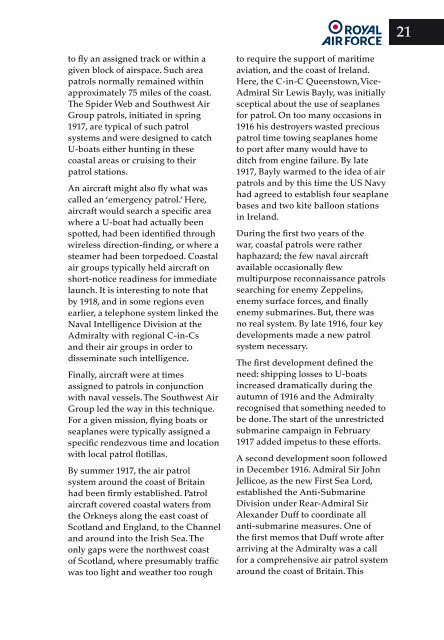You also want an ePaper? Increase the reach of your titles
YUMPU automatically turns print PDFs into web optimized ePapers that Google loves.
to fly an assigned track or within a<br />
given block of airspace. Such area<br />
patrols normally remained within<br />
approximately 75 miles of the coast.<br />
The Spider Web and Southwest <strong>Air</strong><br />
Group patrols, initiated in spring<br />
1917, are typical of such patrol<br />
systems and were designed to catch<br />
U-boats either hunting in these<br />
coastal areas or cruising to their<br />
patrol stations.<br />
An aircraft might also fly what was<br />
called an ‘emergency patrol.’ Here,<br />
aircraft would search a specific area<br />
where a U-boat had actually been<br />
spotted, had been identified through<br />
wireless direction-finding, or where a<br />
steamer had been torpedoed. Coastal<br />
air groups typically held aircraft on<br />
short-notice readiness for immediate<br />
launch. It is interesting to note that<br />
by 1918, and in some regions even<br />
earlier, a telephone system linked the<br />
Naval Intelligence Division at the<br />
Admiralty with regional C-in-Cs<br />
and their air groups in order to<br />
disseminate such intelligence.<br />
Finally, aircraft were at times<br />
assigned to patrols in conjunction<br />
with naval vessels. The Southwest <strong>Air</strong><br />
Group led the way in this technique.<br />
For a given mission, flying boats or<br />
seaplanes were typically assigned a<br />
specific rendezvous time and location<br />
with local patrol flotillas.<br />
By summer 1917, the air patrol<br />
system around the coast of Britain<br />
had been firmly established. Patrol<br />
aircraft covered coastal waters from<br />
the Orkneys along the east coast of<br />
Scotland and England, to the Channel<br />
and around into the Irish Sea. The<br />
only gaps were the northwest coast<br />
of Scotland, where presumably traffic<br />
was too light and weather too rough<br />
to require the support of maritime<br />
aviation, and the coast of Ireland.<br />
Here, the C-in-C Queenstown, Vice-<br />
Admiral Sir Lewis Bayly, was initially<br />
sceptical about the use of seaplanes<br />
for patrol. On too many occasions in<br />
1916 his destroyers wasted precious<br />
patrol time towing seaplanes home<br />
to port after many would have to<br />
ditch from engine failure. By late<br />
1917, Bayly warmed to the idea of air<br />
patrols and by this time the US Navy<br />
had agreed to establish four seaplane<br />
bases and two kite balloon stations<br />
in Ireland.<br />
During the first two years of the<br />
war, coastal patrols were rather<br />
haphazard; the few naval aircraft<br />
available occasionally flew<br />
multipurpose reconnaissance patrols<br />
searching for enemy Zeppelins,<br />
enemy surface forces, and finally<br />
enemy submarines. But, there was<br />
no real system. By late 1916, four key<br />
developments made a new patrol<br />
system necessary.<br />
The first development defined the<br />
need: shipping losses to U-boats<br />
increased dramatically during the<br />
autumn of 1916 and the Admiralty<br />
recognised that something needed to<br />
be done. The start of the unrestricted<br />
submarine campaign in February<br />
1917 added impetus to these efforts.<br />
A second development soon followed<br />
in December 1916. Admiral Sir John<br />
Jellicoe, as the new First Sea Lord,<br />
established the Anti-Submarine<br />
Division under Rear-Admiral Sir<br />
Alexander Duff to coordinate all<br />
anti-submarine measures. One of<br />
the first memos that Duff wrote after<br />
arriving at the Admiralty was a call<br />
for a comprehensive air patrol system<br />
around the coast of Britain. This<br />
21

















